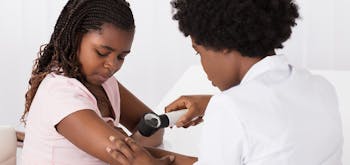Do You Have Enough “Skin in the Game” When It Comes to Sun Safety?
Your skin is amazing! It has about 11 miles of blood vessels to provide nutrients and help keep you at a comfortable and healthy temperature; 650 sweat glands to keep your body at a normal 98.6 degrees; and 1,000 nerve endings that let you sense and react to pain, heat, cold, and pressure. Your skin protects your muscles, bones, and organs from infections and disease. Every minute of every day, your skin is hard at work to protect you. And it’s very important you do everything you can to protect every inch of it (which equals about 3,024 square inches!) from harmful UV rays from the sun and tanning beds.
May is National Skin Cancer Awareness Month, a great time for you to make sure you know how to protect your skin — and that you do take the steps that can help prevent skin cancer. Protecting your skin from the sun is especially important this time of year, when we tend to engage in more outside activities. However, skin protection and awareness of “danger signs” are year-round necessities — whether the sun is shining; skies are overcast; or temperatures are hot, cold, or in between. And though certain people may be at greater risk of skin cancer due to their job, cancer history, or other risk factors, no one is exempt. Regardless of age, sex, climate, or lifestyle, every person needs to actively protect their skin. Here are some tips to get you started.
Protection.
The more of these steps you can take to protect yourself from sun exposure, the better off you’ll be in preventing skin cancer down the road.
- Take cover. Seek the shade of trees, umbrellas, awnings, and the like when you’re outside.
- Cover up. Cover yourself as much as possible with clothing that has a tightly woven fabric. Wear long-sleeve shirts, long pants and skirts, and hats with wide brims all the way around and flaps that cover your ears and back of your neck. Also remember that T-shirts alone are typically not great protection and that darker colors can be more beneficial.
- Look smart. Protect your eyes with sunglasses — wrap-around options are ideal — that block at least 99% of UV light.
- Use lip balm. Choose options with an SPF of 30 or higher.
- Limit your time in the sun. It takes only 15 minutes for the sun’s UV rays to damage your skin. It’s especially important to reduce sun exposure from 10 a.m. to 4 p.m., when these rays are most dangerous.
- Use water-resistant sunscreen with UVA and UVB protection and a broad-spectrum SPF of 30 or higher. Sunscreen is your best defense! Apply it generously every two to three hours, or more often if you swim or sweat.
Know your skin, know the signs.
A change in your skin — such as a new growth, a sore that doesn’t disappear, or a mole — can be a sign of skin cancer. Anytime you notice something unusual, you should bring it to the attention of your health care provider. Ideally, you should be examined by a dermatologist, who is a doctor specializing in skin disease, is trained to recognize problems, and is best equipped to help treat them. The “A-B-C-D-E” method is a great way to remember warning signs of melanoma, the most dangerous form of skin cancer. If you can answer “yes” to one or more of these questions, visit your health care provider as soon as possible.
- Asymmetrical: Does the mole or spot on your skin have an unusual shape?
- Border: Is the edge irregular or jagged?
- Color: Is the color uneven?
- Diameter: Is it larger than pea-sized?
- Evolving: Has it changed over the past several weeks or month?
In the U.S., skin cancer is the most common type of cancer, and approximately 9,000 people die of melanoma annually. However, it’s estimated that half of all cancers are preventable — you can make a huge difference by knowing the signs, being “sun smart,” and taking the steps above. So this spring, “get more skin in the game” when it comes to sun protection. Take care of yourself and make sure children and seniors you look after do the same. Learn more about risk factors, protection, and prevention at HealthyDelaware.org.
